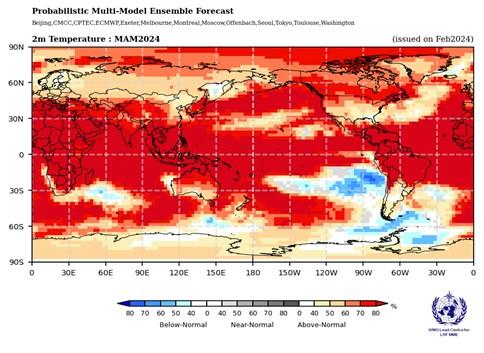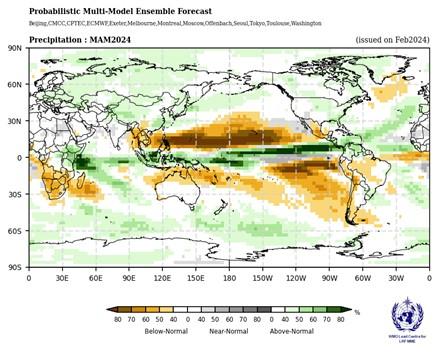El Niño weakens but impacts continue
The 2023-24 El Niño has peaked as one of the five strongest on record. It is now gradually weakening but it will continue to impact the global climate in the coming months, fuelling the heat trapped by greenhouse gases from human activities. Above normal temperatures are predicted over almost all land areas between March and May.
- El Niño peaked in December as one of five strongest on record
- El Niño and climate change fuel record temperatures and extreme events
- Global ocean temperatures are record high
- Early warnings and climate services save lives and livelihoods

A new Update from the World Meteorological Organization (WMO) says there is about a 60% chance of El Niño persisting during March-May and a 80% chance of neutral conditions (neither El Niño or La Niña) in April to June. There is a chance of La Niña developing later in the year, but the odds are currently uncertain.
El Niño occurs on average every two to seven years, and typically last nine to 12 months. It is a naturally occurring climate pattern associated with warming of the ocean surface in the central and eastern tropical Pacific Ocean. It influences weather and storm patterns in different parts of the world. But it takes place in the context of a climate being changed by human activities.
“Every month since June 2023 has set a new monthly temperature record – and 2023 was by far the warmest year on record. El Niño has contributed to these record temperatures, but heat-trapping greenhouse gases are unequivocally the main culprit,” says WMO Secretary-General Celeste Saulo.
“Ocean surface temperatures in the equatorial Pacific clearly reflect El Niño. But sea surface temperatures in other parts of the globe have been persistently and unusually high for the past 10 months. The January 2024 sea-surface temperature was by far the highest on record for January. This is worrying and can not be explained by El Niño alone,” says Celeste Saulo.
El Niño typically has the greatest impact on the global climate in the second year of its development – in this instance 2024.
The continuing, albeit weaker, El Niño and predicted above-normal sea-surface temperatures over much of the global oceans are expected to lead to above-normal temperatures over almost all land areas in the next three months, and influence regional rainfall patterns, according to a Global Seasonal Climate Update issued by WMO to accompany its El Niño/La Niña Update.
Early warnings save lives
The current El Niño event, which developed in June 2023, was at its strongest between November and January. It displayed a peak value of about 2.0 °C above the 1991 to 2020 average sea surface temperature for the eastern and central tropical Pacific Ocean. This made it one of the five strongest El Nino events ever, though it was weaker than the 1997/98 and 2015/2016 events.
El Niño is mainly a seasonal climate phenomenon with climate impacts on seasonal climate averages but can make extreme weather and climate-events more likely in certain regions. Furthermore, the seasonal forecasts are found to be more accurate during El Niño and La Niña events, particularly in the tropics, and this emphasizes the pivotal role of early warnings to support decision-making and enhance preparedness and anticipatory action.
El Niño is associated with increased rainfall triggering flooding in the Horn of Africa and the southern United States of America, and unusually dry and warm conditions in South East Asia, Australia and southern Africa. It has exacerbated drought in northern South America and has also contributed to drier and warmer conditions in parts of southern Africa.
“El Niño events have a major impact on societies and economies. Accurate seasonal forecasts from the WMO community helped countries prepare in advance to try to limit the damage in climate sensitive sectors like agriculture, water resources and health. Early warnings of weather and climate extremes associated with El Niño have saved countless lives,” said Celeste Saulo.

Global Seasonal Climate Update
El Niño and La Niña are major – but not the only – drivers of the Earth’s climate system.
In addition to the long-established ENSO Update, WMO now also issues regular Global Seasonal Climate Updates (GSCU), which incorporate influences of other climate phenomenon such as the North Atlantic Oscillation, the Arctic Oscillation and the Indian Ocean Dipole.
The Global Seasonal Climate Update says that Positive temperature anomalies are expected over almost the entire Northern Hemisphere except in the far south-eastern part of North America, as well as over most of the land areas in the Southern Hemisphere.
Predictions for rainfall in the forthcoming three months (March to May) are similar to some of the canonical rainfall patterns associated with El Niño.
The WMO El Niño/La NIña and Global Seasonal Climate Updates as part of the Early Warnings for All initiative are based on forecasts from WMO Global Producing Centres of Long-Range Forecasts and are available to support governments, the United Nations, humanitarian agencies and decision-makers to mobilize preparations and protect lives and livelihoods.
National Meteorological and Hydrological Services (NMHSs) will closely monitor the situation in the months to come and provide updated outlooks on the dissipation of El Niño and the possible development of La Niña. Uncertainty is typically greater in long-lead forecasts made during the boreal spring and early summer .


The World Meteorological Organization (WMO) is a specialized agency of the United Nations responsible for promoting international cooperation in atmospheric science and meteorology.
WMO monitors weather, climate, and water resources and provides support to its Members in forecasting and disaster mitigation. The organization is committed to advancing scientific knowledge and improving public safety and well-being through its work.
For further information, please contact:
- Clare Nullis WMO media officer cnullis@wmo.int +41 79 709 13 97
- WMO Strategic Communication Office Media Contact media@wmo.int

